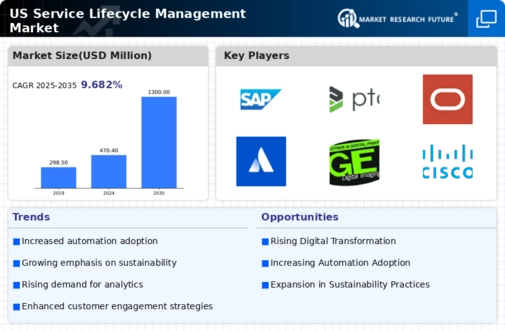The service lifecycle-management market is currently characterized by a dynamic competitive landscape, driven by rapid technological advancements and an increasing demand for integrated solutions. Key players such as ServiceNow (US), IBM (US), and Oracle (US) are at the forefront, each adopting distinct strategies to enhance their market positioning. ServiceNow (US) focuses on innovation through its cloud-based platform, emphasizing automation and user experience, while IBM (US) leverages its extensive portfolio in AI and analytics to provide comprehensive lifecycle management solutions. Oracle (US), on the other hand, is concentrating on expanding its cloud offerings, integrating advanced data management capabilities to streamline service delivery. Collectively, these strategies contribute to a competitive environment that is increasingly centered around technological integration and customer-centric solutions.
In terms of business tactics, companies are increasingly localizing their operations and optimizing supply chains to enhance efficiency and responsiveness. The market structure appears moderately fragmented, with a mix of established players and emerging startups vying for market share. This fragmentation allows for diverse offerings, yet the influence of major players remains substantial, as they set benchmarks for innovation and service quality.
In October 2025, ServiceNow (US) announced a strategic partnership with a leading AI firm to enhance its service automation capabilities. This collaboration is expected to significantly improve the efficiency of service delivery, allowing clients to leverage AI-driven insights for better decision-making. The strategic importance of this partnership lies in its potential to position ServiceNow (US) as a leader in the automation space, thereby attracting a broader client base seeking advanced technological solutions.
In September 2025, IBM (US) unveiled a new suite of lifecycle management tools designed specifically for the healthcare sector. This move is indicative of IBM's strategy to penetrate niche markets with tailored solutions, addressing specific industry needs. By focusing on healthcare, IBM (US) not only diversifies its portfolio but also strengthens its competitive edge in a sector that increasingly relies on digital transformation.
In August 2025, Oracle (US) launched an initiative aimed at enhancing its cloud infrastructure, which includes significant investments in data security and compliance features. This initiative is crucial as it aligns with the growing demand for secure and compliant service management solutions, particularly in regulated industries. By prioritizing security, Oracle (US) positions itself as a trusted partner for organizations concerned about data integrity and regulatory compliance.
As of November 2025, the competitive trends in the service lifecycle-management market are heavily influenced by digitalization, sustainability, and AI integration. Strategic alliances are becoming increasingly vital, as companies recognize the need to collaborate to enhance their technological capabilities and service offerings. Looking ahead, competitive differentiation is likely to evolve from traditional price-based competition to a focus on innovation, technology integration, and supply chain reliability. This shift underscores the importance of adaptability and forward-thinking strategies in maintaining a competitive edge in a rapidly changing market.

















Leave a Comment